Nambu World:
Sino-Japanese War Medal 1894-95

Although
Here is the back. All the Japanese medals I
have use this type of hook-and-eye attachment.
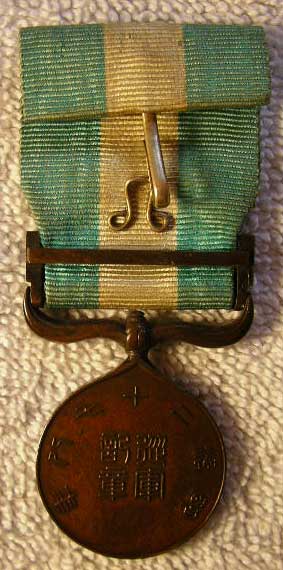
Here is a close-up of the front. It is about
30mm (1-3/16”) in diameter.

The back has four characters in the middle.
They read top to bottom, right column first: ju-gun-ki-sho, meaning “war medal”. The ones around the edge start
in the lower right and go counter-clockwise: mei-ji-ni-ju-nana-hachi-nen, meaning Meiji 27-8 year. This is the
date of the war according to the Japanese system. The 27th and 28th
years of the reign of the Meiji Emperor correspond to 1894-1985. Meiji was the
grandfather of Emperor Hirohito, with whom most Westerners are much more
familiar.
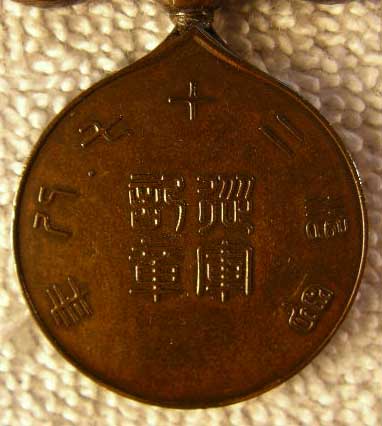
Unlike most later war medals, the bar has no
inscription. Later medals had ju-gun-ki-sho
on the bar rather than on the back.
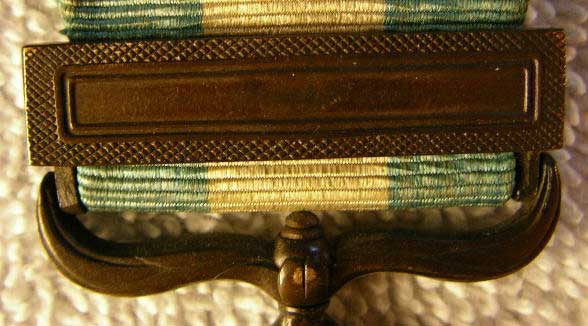
This is the box. OMJAS says it was of black
lacquer on page 41 and of dark brown lacquer on page 44. In any case, it is
markedly different from the later medals, which came in unpainted wooden boxes.

It is held shut by a clasp in the same way as
the boxes for orders (kunsho) shown
in the section that covers them.

Here is a Sino-Japanese War Medal
award certificate. It is 364mm (14-5/16”) high by 456mm (a shade under 18”)
wide. It has no watermarks and no stamps or other marks on the back. The paper
is like parchment, so even though it is thin it is fairly stiff. Sino-Japanese
War certificates are pretty scarce, and this one has special interest because
the recipient was a Captain in the Kempeitai, the Japanese military police, who
had wide-ranging duties that made them much feared in occupied areas. The paper
is rather yellowed, so even when I used colour-correction software the paper
has a yellowish cast in most of the photos.
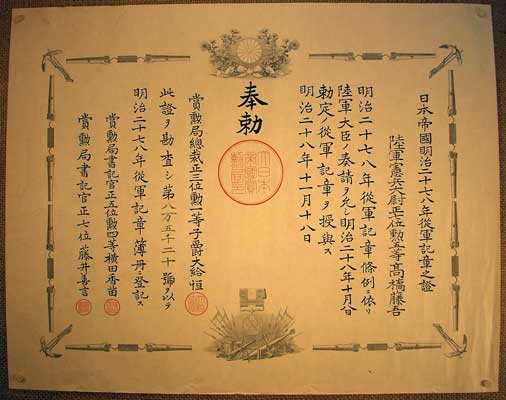
This close-up of the writing on the
right side of the certificate is an exception; the paper isn’t actually this
white. The writing is in the traditional vertical style, reading from top to
bottom, starting in the upper right corner and moving left and starting at the
top again once you reach the bottom of each column.
Here is what it says in Japanese:
First
column on the right: Nip-pon tei-koku
Mei-ji-ni-ju-nana-hachi-nen-ju-gun-ki-sho-no-sho
Second
column from the right: Riku-gun-kem-pei-tai-i-sho-nana-i-kun-go-to-Taka-hashi-To-go
Third column from the right: Mei-ji-ni-ju-nana-hachi-nen-ju-gun-ki-sho-jo-rei-ni-yori
Fourth column from the right: Riku-gun-dai-jin-no-so-seio-in-shi-mei-ji-ni-ju-hachi
nen-ju-gatsu-yo-ka
Fifth column from the right: Choku-tei-no-ju-gun-ki-sho-o-ju-yo-su
Last column on left: Mei-ji-san-ju-kyu-nen-shi-gatsu-ju-hachi-nichi
A rough translation is as follows:
First column on right: “Japanese Empire Certificate for Medal for Military Service during Meiji 27-8 [1894-5]”
Second column: “Army Military Police Captain Togo Takahashi, 7th Rank, Holder of the 5th Order of Merit [this is the name of the recipient; Takahashi, meaning literally “high bridge”, is his surname]
Third to fifth columns: “The Minister of War [literally “of the Army”] has petitioned the Emperor and received permission in accordance with the regulations regarding the Meiji 27-8 military service medal to award [you] this military service medal established by Imperial Edict on October 8, 1895”.
Last column on the left: “Dated January 8, 1895”.

The left side has the formalities from the
Board of Decorations.

Here is a transliteration of the
Japanese characters from right to left:
First
column (far right): sho-kun-kyoku-so-sai-sho-san-i-kun-it-to-shi-shaku-dai-kyu
[or o-kyu]-Tsune [or Hisashi, Hitoshi
or Wataru—there are several possible
pronunciations of the given name].
Second
column: Kono-sho-o-kan-sa-shi-dai-hachi-man-go-sen-ni-ju-go-o-mot-te
Third column:
Mei-ji-ni-ju-nana-hachi-nen-ju-gun-ki-sho-bo-satsu-nito-roku-su.
Fourth column:
Sho-kun-kyoku-sho-ki-kan-sho-go-i-kun-yon-to-yoko-ta-ka-nae.
Fifth
column (far left): Sho-kun-kyoku-sho-ki-kan-sho-nana-i-fuji-i-zen-gen.
Roughly translated, this means:
First
column (far right): President of the Board of Decorations, Third Rank, Holder
of the First Order of Merit, Viscount Tsune Daikyu [family name Daikyu]
Second
& third columns: “Having verified this certificate, we have recorded it as
number 85020 in the register of Meiji 27-8 military service medals”.
Fourth
column: Secretary of the Board of Decorations, 5th Rank, Holder of the 4th
Order of Merit, Kanae Yokota [family name=Yokota].
Fifth
column: Secretary of the Board of Decorations, 7th Rank, Zengen
Fujii [family name=Fujii].
Here are close-ups of the small red
seals that appear at the ends of these columns in each case where it contains a
name. These name stamps are often used instead of signatures in
Here is the first one on the right,
the name stamp of Viscount Tsune Daikyu.

The name stamp of Kanae Yokota.

Zengen Fujii.

Here is a close-up pf the Imperial
Chrysanthemum that appears at the top centre of the certificate.

This is the large seal that appears
just below that. It has three columns of characters and is read column by
column, right to left, starting in the upper right. It says Dai nippon teikoku shokunkyokuin. That means “Seal of the
Empire of Greater Japan Board of Decorations”.
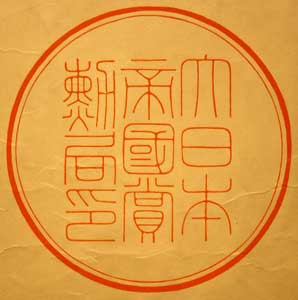
Here is a close-up of the artwork at the lower
centre of the certificate.
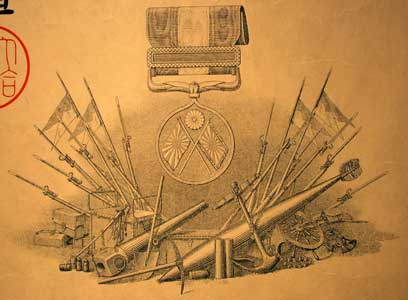
I have another item from the
Sino-Japanese War and this is as good a place to show it as any. The following
photo is a woodblock print entitled Nisshin
gekisen wagun daishori no zu (“Great Victory by the Japanese Army in the
Hard-Fought War Against China”). Including the border
it is 506 mm by 343 mm (20” by 13.5”). At the bottom it says it was printed on
September 8, Meiji 27 (1894), and published (released) on September 10 of that
year in

In this close-up of the lower right
of the print Japanese soldiers have their rifles by the muzzles and are
wielding them like clubs as they chase the stereo-typed Chinese soldiers with
pigtails. One Japanese soldier below the flag with the wavy red lines fends off
an attack by a Chinese spear with one hand while wielding his rifle by the
muzzle like a club with the other.

In this close-up of the upper right
of the print there are several intact bodies and a Chinese banner blown into
the air above the point of impact of the cannon shot.
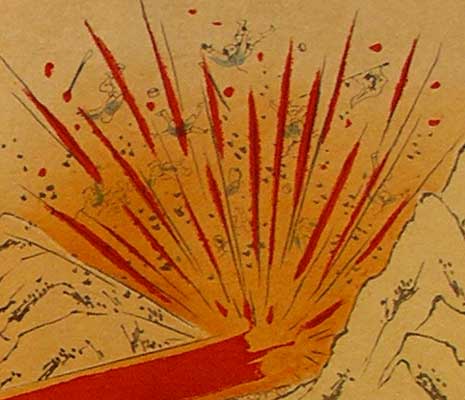
If you would like to know
more about the Sino-Japanese War, I highly recommend the book The Sino-Japanese War of 1894-1895:
Perceptions, Power and Primacy by S.C.M. Paine (
To return to the primary page on
Medals, please click here: Nambu
World: Japanese Medals
To
return to “Other Japanese Militaria”, please click here: Nambu
World: Other Japanese Militaria
To
return to the home page, please click here: Nambu World: Teri’s WWII Japanese
Handgun Website
Last updated: March 15,
2007. All contents are copyright Teri
unless otherwise specified and may not be used elsewhere in any form without
prior permission.